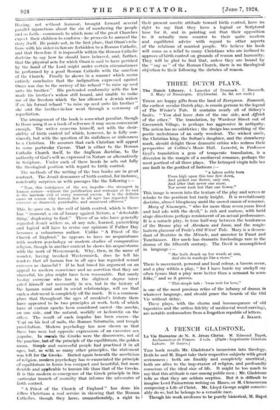THREE DUTCH PLAYS.
THESE arc happy gifts from the land of Everyman. Esmoreit, the earliest secular Dutch play, is cousin german to the legend of The Winter's Tale. It contains nearly all of Sidney's faults. " Yon shal have Asia of the one side, and Affrick of the other." The translation, by Wardour Street out of Greenwich Village, is perhaps too aggressive in antiquity. The action has no subtleties ; the design has something of the poetic melodrama of an early woodcut. The wicked uncle, the Christian king, the Sultan's daughter, and the strawberry mark, should delight those dramatic critics who redress their perspective at Collins's Music Hall. Lancelot, in Professor Geyl's translation a gem of temperate transfusion, is a diversion in the margin of a mediaeval romance, perhaps the most poetical of all three plays. The betrayed virgin tells her one fault in the gentlest of fashions :— " a falcon nobly born
From high upon this tree flew down, And picked one flower, only "one, And after that never one more, Nor never took but that one flower."
This image is woven into the texture of the play and serves as rebuke to the penitent but tardy knight. It is revolutionary doctrine, almost blasphemy amid the sacred canon of romance.
Mary of Ninimegen, " who for more than seven years lived and had ado with the devil," is rich and mature, with lurid stage directions perhaps reminiscent of an actual performance. It is a miracle play, in tone half-way between the tenderness of the Brome play of Abraham and Isaac, and the magic- lantern glamour of Peele's Old Wives' Talc. Mary is a descen- dant of Beatrice in the Miracle, and ancestor to Faust and Tarinhauser. Her uncle has dramatic forebodings rare in the drama of the fifteenth century. The Devil is accomplished in language :— " She bath drunk up her wrath at one,
" And sits in wanhope like a stone."
There is movement, personal and local colour, a tavern scene, and a play within a play, " for I have harde my unekyll say often tymes that a play were better than a sermant to sonic folke," and so it proves.
" This simple tale : 'twas writ for love," is one of the most precious relics of the infancy of drama in whatever language, and should grace the boards of the Old Vic without delay.
These plays, with the charm and inconsequence of old tapestries and the artless fidelity of mediaeval wood-carvings, are notable ambassadors from a forgotten republic of letters.
J. ISAACS.










































 Previous page
Previous page